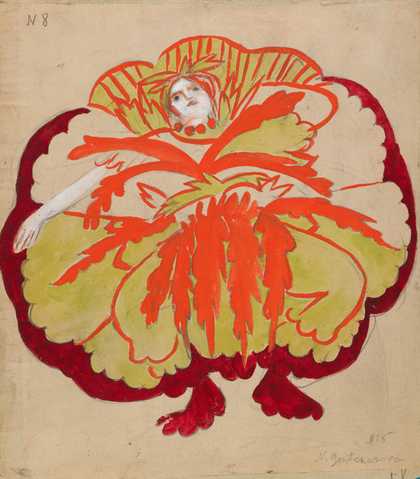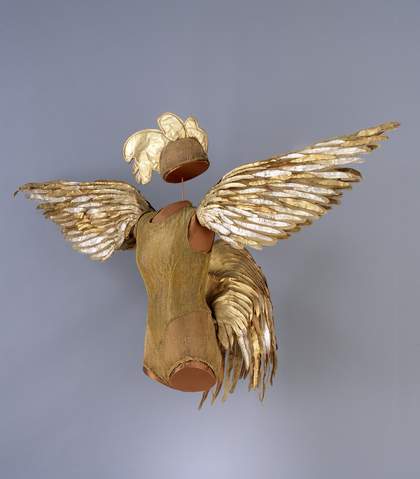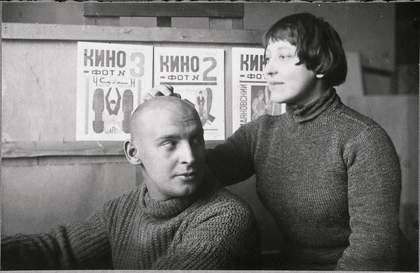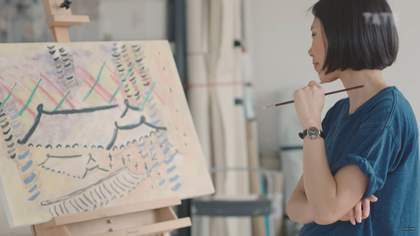Throughout her long and varied career, Natalia Goncharova (1881–1962) challenged the limits of artistic, social and gender conventions.
By the age of 32, she had already established herself as a leader of the Russian avant-garde.
Soon after, she achieved international fame for her vibrant costume and set designs for the Ballets Russes in Paris.
Here are seven things you should know about an artist hailed as 'a model for her generation'.
1. She was the pioneer of Everythingism

Natalia Goncharova
Linen (1913)
Tate
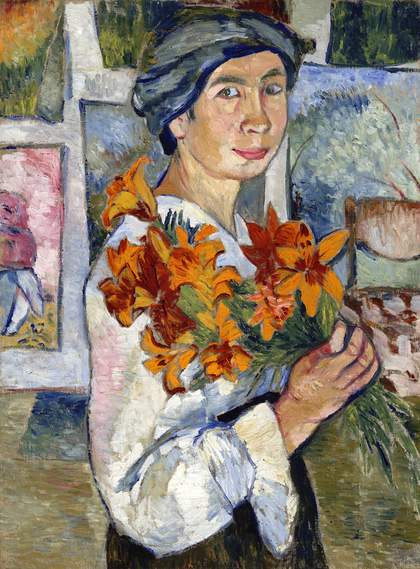
Natalia Goncharova Self-Portrait with Yellow Lilies 1907-1908 State Tretyakov Gallery (Moscow, Russia) © ADAGP, Paris and DACS, London 2019
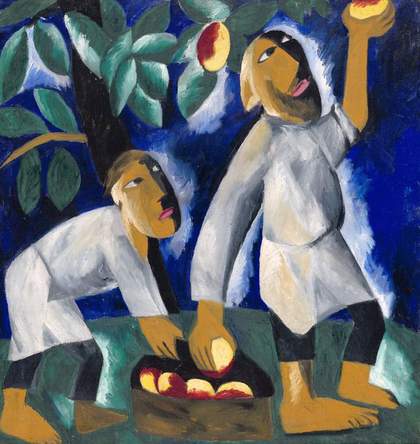
Natalia Goncharova Peasants Picking Apples 1911 State Tretyakov Gallery, Moscow. Transferred from the Museum of Artistic Culture 1929 © ADAGP, Paris and DACS, London 2019
This is according to her first biographer, Ilia Zdanevich. ‘Everythingism’ - vsechestvo in Russian - sums up Goncharova’s artistic approach. Her work combined diverse techniques and styles including painting, print, theatre design, fashion, cinema, interior design, book illustrations and performance art. She also adapted forms of her paintings and theatre designs for stencil prints, posters and lithographs.
The subjects of her art range from still life to nudes, from peasant scenes to abstractions, from futurist landscapes to depictions of the Apocalypse.
We acknowledge all styles as suitable for the expression of our art, styles existing both yesterday and today
Natalia Goncharova and Mikhail Larionov
2. She was a leader of the Russian avant-garde
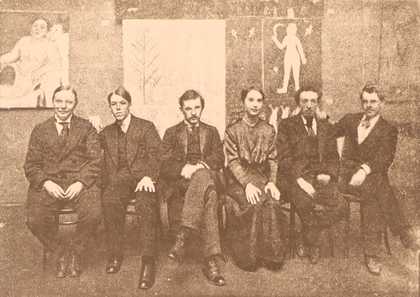
Photograph of the Target exhibition artists (left to right) Mikhail Larionov, Sergei Romanovich, Mikhail Le Dantiu, Natalia Goncharova, Maurice Fabbri, Vladimir Obolensky. Moscow, July 1913. State Tretyakov Gallery, Manuscripts department, Moscow
Moscow was one of the most exciting cities for an artist at the turn of the twentieth century. While studying sculpture at art school, Goncharova became involved in some of the city's most cutting-edge art movements and exhibitions.
Along with her partner, the artist Mikhail Larionov, she founded radical artist groups including the Jack of Diamonds, Donkey’s Tail and Target. She exhibited together with Wassily Kandinsky, Kazemir Malevich and Vladimir Tatlin. She also collaborated with the futurists David Burliuk and Vladimir Mayakovsky. Together with Velimir Khlebnikov and Aleksei Kruchenykh she published zaum poetry. This was a type of sound poetry that used an invented language.
3. She was famous in her lifetime

Natalia Goncharova with ‘Basic makeup for an actress of the Futurist theatre’ published in Teatr v karrikaturakh, 21 September 1913, p.9 Photograph courtesy of Andrei Sarabianov
In 1913 Goncharova wowed Moscow with her first major retrospective. Taking place at the Art Salon on Bolshaya Dmitrovka Street, the exhibition included over 800 works.
This was the first monographic exhibition of any member of the Russian avant-garde. It confirmed Goncharova as one of the country’s most successful and radical artists.
A few weeks before the opening, Goncharova and fellow artists paraded through the streets of Moscow with hieroglyphic patterns painted on their faces. Journalists had been tipped off in advance, so the streets were lined with curious crowds and photographers keen to find out more.
This clever publicity stunt obviously worked. Over 12,000 people visited the exhibition and 31 works were sold.
Not bad for an artist in her early thirties.
4. She created a new art form
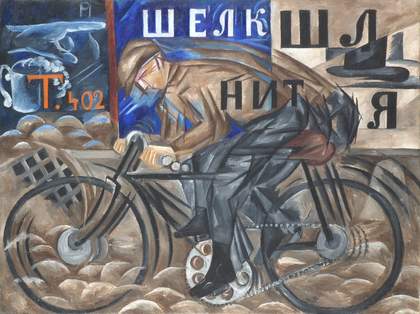
Natalia Goncharova Cyclist 1913 State Russian Museum (St Petersburg, Russia) © ADAGP, Paris and DACS, London 2019
Together with Larionov, Goncharova developed a new abstract art movement. They called this rayonism or rayism. Emerging from Cubism and Futurism, the style was based on the effect of reflected light on surfaces.
The objects that we see in life play no role here, but that which is the essence of painting itself can be shown here best of all - the combination of colour, its saturation, the relation of coloured masses, depth, texture; anyone who is interested in painting can give his full attention to all these things.
Natalia Goncharova and Mikhail Larionov, Rayonists and Futurists: A Manifesto, 1913
5. She was inspired by folk art
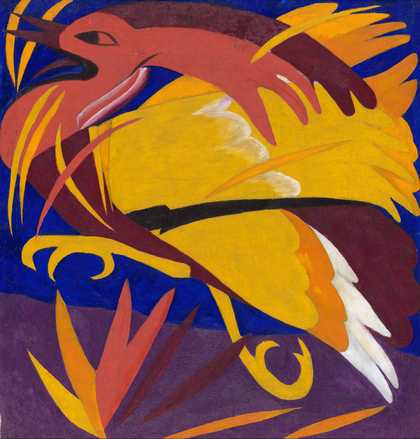
Natalia Goncharova The Phoenix (Harvest polyptych) 1911 State Tretyakov Gallery (Moscow, Russia) © ADAGP, Paris and DACS, London 2019
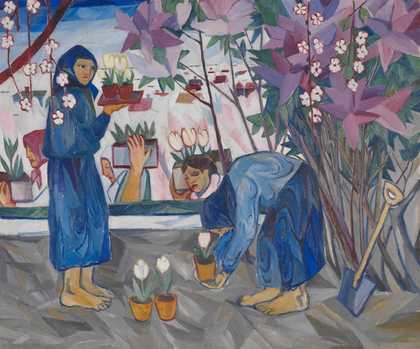
Natalia Goncharova
Gardening (1908)
Tate
Modern French painters opened my eyes, and I grasped the great importance and value of the art of my native land, and through it, the value of the art of the East.
Natalia Goncharova
Rayonism wasn't the only art form created by Goncharova and Larionov. Together they developed neo-primitivism. This was a style of painting that combined Western modernism with traditional Russian folk art forms. These included the ‘lubok’ (a popular Russian print), icon painting and shop signboards.
Many of Goncharova’s early paintings are inspired by the peasant life and culture of her native Tula province in Central Russia.
6. Her work was censored

Natalia Goncharova The Deity of Fertility 1909-1910 State Tretyakov Gallery (Moscow, Russia) © ADAGP, Paris and DACS, London 2019
Critics were outraged by a 1910 exhibition of work by Goncharova.
They were especially shocked by the way she represented female nudes and used them as models and subjects in paintings about pagan mythology.
The Deity of Fertility was one of the works confiscated by the police. The artist was charged with violating a law relating to the public display of ‘corrupting’ images.
A few years later, her painting The Evangelists was removed from an exhibition in St Petersburg. The censors considered it blasphemous.
7. She transformed theatre design
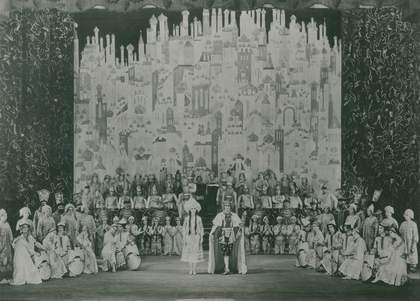
A scene from the ballet The Firebird, 1950s
Sergei Diaghilev founded the Ballets Russes in 1909. His dance company wowed audiences across Europe with their trailblazing performances. In 1913 Goncharova accepted Diaghilev’s invitation to make sets and costumes for the opera-ballet, Le Coq d’or (The Golden Cockerel). She went on to design costumes and sets for composer Igor Stravinksy’s ballets L'Oiseau de feu (The Firebird) and Les Noces (The Wedding). These included elements of Russian folk traditions.
She remained involved with theatre for the rest of her life. Goncharova was one of only two women who designed for Diaghilev’s Ballets Russes. She was the only one involved in stage design.
Goncharova’s designs are simply fabulous! They are exceedingly poetic and very interesting in terms of colour
Serge Diaghilev
The first UK retrospective of Natalia Goncharova is at Tate Modern 6 June – 8 September 2019.

